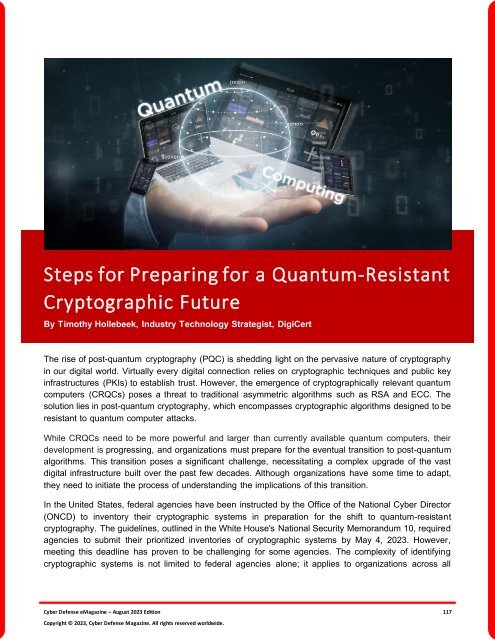The Cyber Defense eMagazine August Edition for 2023
Cyber Defense eMagazine August Edition for 2023 #CDM #CYBERDEFENSEMAG @CyberDefenseMag by @Miliefsky a world-renowned cyber security expert and the Publisher of Cyber Defense Magazine as part of the Cyber Defense Media Group as well as Yan Ross, Editor-in-Chief and many more writers, partners and supporters who make this an awesome publication! Thank you all and to our readers! OSINT ROCKS! #CDM #CDMG #OSINT #CYBERSECURITY #INFOSEC #BEST #PRACTICES #TIPS #TECHNIQUES
Cyber Defense eMagazine August Edition for 2023 #CDM #CYBERDEFENSEMAG @CyberDefenseMag by @Miliefsky a world-renowned cyber security expert and the Publisher of Cyber Defense Magazine as part of the Cyber Defense Media Group as well as Yan Ross, Editor-in-Chief and many more writers, partners and supporters who make this an awesome publication! Thank you all and to our readers! OSINT ROCKS! #CDM #CDMG #OSINT #CYBERSECURITY #INFOSEC #BEST #PRACTICES #TIPS #TECHNIQUES
You also want an ePaper? Increase the reach of your titles
YUMPU automatically turns print PDFs into web optimized ePapers that Google loves.
Steps <strong>for</strong> Preparing <strong>for</strong> a Quantum-Resistant<br />
Cryptographic Future<br />
By Timothy Hollebeek, Industry Technology Strategist, DigiCert<br />
<strong>The</strong> rise of post-quantum cryptography (PQC) is shedding light on the pervasive nature of cryptography<br />
in our digital world. Virtually every digital connection relies on cryptographic techniques and public key<br />
infrastructures (PKIs) to establish trust. However, the emergence of cryptographically relevant quantum<br />
computers (CRQCs) poses a threat to traditional asymmetric algorithms such as RSA and ECC. <strong>The</strong><br />
solution lies in post-quantum cryptography, which encompasses cryptographic algorithms designed to be<br />
resistant to quantum computer attacks.<br />
While CRQCs need to be more powerful and larger than currently available quantum computers, their<br />
development is progressing, and organizations must prepare <strong>for</strong> the eventual transition to post-quantum<br />
algorithms. This transition poses a significant challenge, necessitating a complex upgrade of the vast<br />
digital infrastructure built over the past few decades. Although organizations have some time to adapt,<br />
they need to initiate the process of understanding the implications of this transition.<br />
In the United States, federal agencies have been instructed by the Office of the National <strong>Cyber</strong> Director<br />
(ONCD) to inventory their cryptographic systems in preparation <strong>for</strong> the shift to quantum-resistant<br />
cryptography. <strong>The</strong> guidelines, outlined in the White House's National Security Memorandum 10, required<br />
agencies to submit their prioritized inventories of cryptographic systems by May 4, <strong>2023</strong>. However,<br />
meeting this deadline has proven to be challenging <strong>for</strong> some agencies. <strong>The</strong> complexity of identifying<br />
cryptographic systems is not limited to federal agencies alone; it applies to organizations across all<br />
<strong>Cyber</strong> <strong>Defense</strong> <strong>eMagazine</strong> – <strong>August</strong> <strong>2023</strong> <strong>Edition</strong> 117<br />
Copyright © <strong>2023</strong>, <strong>Cyber</strong> <strong>Defense</strong> Magazine. All rights reserved worldwide.

















